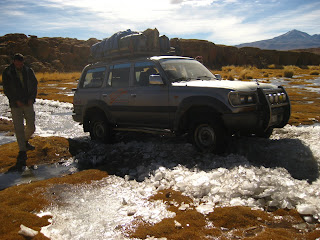Day 1:
Our tour group was nice and small—in addition to the driver and the cook, there were two friendly guys from Quebec, plus Kim and me. On the first day we ascended a steep mountain and had great views of some jagged rock formations.

Once we were on the high plains, we saw lots of wild animals—mostly llamas, but also some donkeys, vicuñas, and weird-looking birds that sort of resembled small ostriches.

We spent the first night in a tiny village called San Antonio de Lipez, which has an altitude of 4192 meters above sea level (that’s over two and a half miles). We got winded just walking around! In contrast, the local kids had no problem with the thin air; they barely seemed tired after their soccer game.

Day 2:
It gets pretty cold on the high plains, so we had to make our way through some ice. At one point our 4x4 got stuck, but our driver (who was excellent) had us out within ten minutes.
We went to Laguna Verde (Green Lagoon), which is right by the border with Chile. The lagoon is at its greenest when there’s lots of sun and lots of wind. We had plenty of the latter, but it was a little cloudy, so the lagoon was only somewhat green. Still, it was a pretty amazing sight.
Later in the afternoon, we reached our highest altitude of the trip: 5000 meters above sea level (over three miles)! Fortunately, our altitude sickness pills worked like a charm. We stopped by a geyser field where there were lots of bubbling pools of boiling mud.
Day 3: In the middle of a flat desert, there were suddenly a bunch of weird rock formations sticking out of the ground.
Later in the day we stopped by a lagoon that was filled with flamingos. The lagoon was mostly frozen, so the flamingos walked on the ice and stuck their heads into the water in search of food.

That night we stayed at the Salt Hotel. As the name suggests, it’s a hotel made of salt: tables, chairs, floors, walls—even the box springs of our beds—were all made of salt.

Day 4:

It’s a good place to take funny pictures, too.


Now we’re in La Paz, which is one of Bolivia’s two capitals. (We won’t be visiting Sucre, the other capital.) We just arrived in La Paz yesterday, so there’s not much to say yet—other than the fact that the view from our hotel room is fantastic!

After a few more days in La Paz, we plan to head over to Lake Titicaca. The seven-year-old boy in me can’t help but snicker every time I say that word.




No comments:
Post a Comment